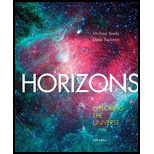
Why have astronomers added modern constellations to the sky?
Why the astronomers have added modern constellations to the sky.
Answer to Problem 1RQ
The astronomers have added modern constellations to the sky to include faint stars and to define constellation boundaries.
Explanation of Solution
Introduction:
Constellations are groups of stars in the sky that have been seen to have a definite pattern and occupy a defined area in the sky. The patterns of stars have been studied from ancient times and have been accorded with names of illustrious heroes.
The known stars were grouped into constellations and 48 constellations were known from ancient times. But the skies also have many faint stars, which were not grouped into any constellation. Further, there existed a dispute in a star being a part of a constellation. A star could be a part of two different constellations. The boundaries of the constellations were not defined.
Therefore, the astronomers have included the faint stars in the sky into constellations, by creating new constellations. The boundaries of the constellations were fixed and the disagreement regarding the stars and the constellation they belonged to was resolved.
The International Astronomical Union has now recognized 88 constellations and has defined the constellations as an area in the sky and all the stars in the area were a part of the constellation. This definition of the constellation included all the stars, faint or otherwise into a constellation, based on the area they occupy in the sky. Since the areas in the sky were clearly demarcated, the boundaries of the constellations became more distinct.
Conclusion:
Thus, the astronomers have added modern constellations to the sky to include faint stars and to define constellation boundaries.
Want to see more full solutions like this?
Chapter 2 Solutions
Horizons: Exploring the Universe (MindTap Course List)
- Why does the number of circumpolar constellations depend on the latitude of the observer?arrow_forwardAll cultures on Earth named constellations. Why do you suppose this was such a common practice?arrow_forwardWhat is a constellation as astronomers define it today? What does it mean when an astronomer says, “I saw a comet in Orion last night”?arrow_forward
 An Introduction to Physical SciencePhysicsISBN:9781305079137Author:James Shipman, Jerry D. Wilson, Charles A. Higgins, Omar TorresPublisher:Cengage Learning
An Introduction to Physical SciencePhysicsISBN:9781305079137Author:James Shipman, Jerry D. Wilson, Charles A. Higgins, Omar TorresPublisher:Cengage Learning AstronomyPhysicsISBN:9781938168284Author:Andrew Fraknoi; David Morrison; Sidney C. WolffPublisher:OpenStax
AstronomyPhysicsISBN:9781938168284Author:Andrew Fraknoi; David Morrison; Sidney C. WolffPublisher:OpenStax Stars and Galaxies (MindTap Course List)PhysicsISBN:9781337399944Author:Michael A. SeedsPublisher:Cengage Learning
Stars and Galaxies (MindTap Course List)PhysicsISBN:9781337399944Author:Michael A. SeedsPublisher:Cengage Learning Stars and GalaxiesPhysicsISBN:9781305120785Author:Michael A. Seeds, Dana BackmanPublisher:Cengage Learning
Stars and GalaxiesPhysicsISBN:9781305120785Author:Michael A. Seeds, Dana BackmanPublisher:Cengage Learning
 Foundations of Astronomy (MindTap Course List)PhysicsISBN:9781337399920Author:Michael A. Seeds, Dana BackmanPublisher:Cengage Learning
Foundations of Astronomy (MindTap Course List)PhysicsISBN:9781337399920Author:Michael A. Seeds, Dana BackmanPublisher:Cengage Learning





